Sprain vs Strain: What's the difference?
January 3rd, 2017 | 5 min. read
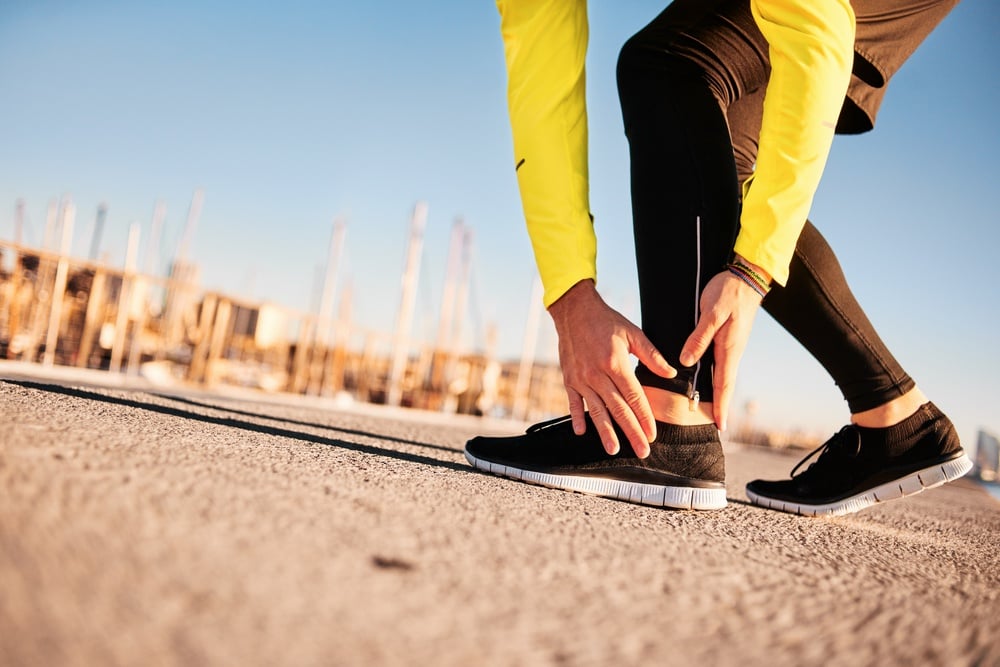
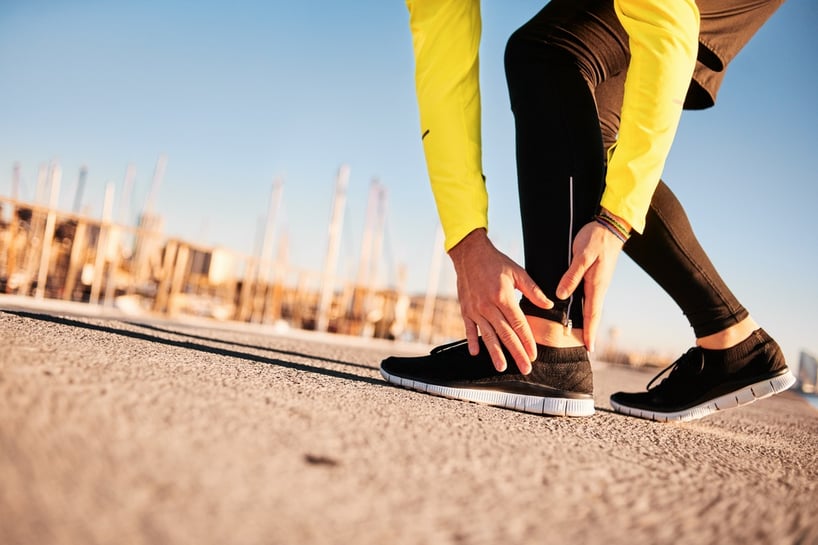
Most active people at some point in their lives have experienced either a sprain or strain. These are usually fairly uncomplicated injuries to ligaments, muscles, or tendons, but they can happen suddenly, hurt quite a bit, and unfortunately, keep you from some of your regular activities until they heal.
Sprains and strains are common — but how can you tell the difference between them? Which type of injury have you sustained?
What’s the difference between a sprain VS strain?
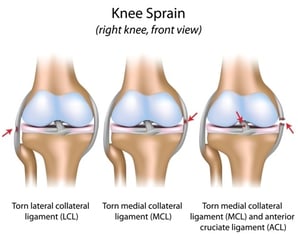
A sprain occurs when you overstretch or tear a ligament (the bands of fibrous tissue that connect your bones to each other).
One of the most common sprains you may have heard about is a sprain to the ACL, a ligament in the center of the knee
which connects your femur (the long bone of your thigh) to your tibia (a bone in your calf). Ankle sprains are also extremely common. These involve twisting the ankle too far past its normal range of motion, to the point where tears develop in the ligaments that connect the foot and leg bones.
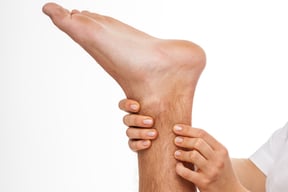 A strain is the same type of soft tissue pull or tear, but it affects muscles or tendons (the cords of fibrous tissue that anchor your muscles to your bones). Many people ask, “What’s the difference between a strain and a pulled muscle?” The answer is, “There is no difference.” A muscle strain and a pulled muscle are the same thing. Both involve the tissue being stretched beyond its normal length, which can lead to painful tears. However, tendons can also be strained — for example, the Achilles tendon at the back of the ankle, or the tendons attaching your biceps to your humerus (the long bone of your upper arm).
A strain is the same type of soft tissue pull or tear, but it affects muscles or tendons (the cords of fibrous tissue that anchor your muscles to your bones). Many people ask, “What’s the difference between a strain and a pulled muscle?” The answer is, “There is no difference.” A muscle strain and a pulled muscle are the same thing. Both involve the tissue being stretched beyond its normal length, which can lead to painful tears. However, tendons can also be strained — for example, the Achilles tendon at the back of the ankle, or the tendons attaching your biceps to your humerus (the long bone of your upper arm).
Sprains and strains are very similar in nature. Both involve over-stretching and tearing. Usually, this type of injury is sudden — the result of:
- over-extensions: bending too deeply into a lunge or kicking your leg too high doing a cheer
- sudden compressions or forceful impacts: for example, being tackled in football or checked against a wall in hockey
- pivots: wrenching your knee when sliding into home base or twisting to keep a football away from an opponent
- landings: making a basketball jump shot or leaping over a ski mogul
- falls and accidents: twisting your ankle on a cobblestone street, or slamming your shoulder against the ground when slipping and falling on a wet floor or ice
Sudden sprains and strains of this nature are referred to as acute.
However, you can also sustain a chronic sprain or strain that develops over time — for example, by typing eight hours per day at work or playing golf several times a week (the repetitive motions of a golf swing can lead to wrist, shoulder, or back injuries).
Athletes and workers who put stress on the same joint or muscle group over and over are particularly susceptible to chronic injuries like this.
Symptoms
How do you know if you’ve sustained a sprain or strain? The signs can vary depending on how badly you’ve hurt yourself. Generally speaking, however, the symptoms are similar.
Sprains usually involve some or all of the following:
- Pain
- Swelling
- Bruising
- Difficulty moving your joint
- A popping sound or feeling at the time of injury
For example, if you roll your ankle you may hear or feel something giving way. Oftentimes, the ankle will swell up immediately, leading to stiffness, and sometimes bruises will form around the site of injury.
Strains are typified by some or all of these symptoms:
- Pain
- Swelling
- Muscle spasms
- Weakness in the muscle
- Difficulty moving the injured muscle
- A dent or gap in the shape of the muscle
Strains to muscles and tendons have similar symptoms as ligament sprains.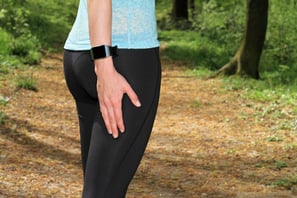 Because they directly affect your muscles, however, you may notice your muscle spasming or tightening up. For example, if you’ve strained a hamstring, you may feel a twitching in the back of your thigh, in addition to having difficulty putting weight on the affected leg.
Because they directly affect your muscles, however, you may notice your muscle spasming or tightening up. For example, if you’ve strained a hamstring, you may feel a twitching in the back of your thigh, in addition to having difficulty putting weight on the affected leg.
Sprain versus strain: which is worse?
It depends. Both types of injury can be mild to moderate (grades I or II); both can be severe (grade III), typified by total rupture requiring surgery to repair the tissue. The seriousness of your injury can also vary depending on where the damage occurred. For example, a severe back strain may keep you bedridden for months, whereas a sprained wrist may recover in a few weeks.
Some experts say muscles heal faster than ligaments and tendon because they’re richer in blood flow. However, every injury is a unique case.
Causes of sprains and strains
 Most acute soft tissue pulls and tears can be avoided through proper warm-up before workouts and regular stretching after workouts. Warmup distributes blood to your muscles, loosening them and increasing your range of motion — which makes it more difficult for you to accidentally pull or tear something. Stretching after workouts preserves your range of motion and helps to keep your muscles long and flexible.
Most acute soft tissue pulls and tears can be avoided through proper warm-up before workouts and regular stretching after workouts. Warmup distributes blood to your muscles, loosening them and increasing your range of motion — which makes it more difficult for you to accidentally pull or tear something. Stretching after workouts preserves your range of motion and helps to keep your muscles long and flexible.
You should also be well-rested. Condition your body slowly. Don’t push yourself too hard too soon — or too hard when you’re tired. Don’t overdo it if you haven’t slept well or are run down or feeling weak. Don’t exercise when you’re sick, either. Poor judgment is a common cause of injuries.
Make sure to exercise correctly and safely, using proper equipment (including the right footwear). If you play racquet sports, make sure your strings aren’t loose. If you golf, are your clubs the right length for your height? How about those running shoes — how many miles have you clocked on them, and are the treads still good? Checking your sporting equipment’s condition is critical to staying healthy. Worn, old, or poorly fitted gear can force your body to work harder to achieve the same results.
Frequently, physical therapists and orthopedists see acute sprains and strains in weekend warriors. If you’re inactive all week, your body may not be properly conditioned for sudden bursts of activity on the weekend. Weak muscles are more likely to be overstretched the the point of developing tears.
Lastly, make sure you’re exercising on a well-maintained, even surface. Take extra care if you’re not — hiking or trail running on uneven ground is a major cause of twisted ankles.
Commonly sites of injury
Sprains:
- ankle and foot (People sometimes ask doctors, “What is the difference between a sprained ankle and a torn ligament?” The answer: a sprain is a partial tear; the ankle can be stabilized and repaired without surgery. A fully torn or ruptured ligament means the ligament ends or torn and don’t line up; repairing them requires surgery.)
- back: cervical sprains, lumbar sprains, thoracic sprains
- knee
- neck
- shoulder
- wrist
Strains:
- ankle and foot
- back: cervical strains, lumbar strains, thoracic strains
- knee
- neck
- shoulder
- wrist
Treating and rehabbing sprains and strains
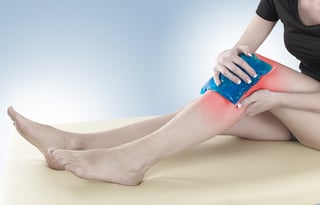 If you’ve sustained an acute sprain or strain, the first step is to apply first aid treatment to control swelling. Immediately after injury and within the first 72 hours, you can treat sprains and strains with RICE therapy:
If you’ve sustained an acute sprain or strain, the first step is to apply first aid treatment to control swelling. Immediately after injury and within the first 72 hours, you can treat sprains and strains with RICE therapy:
- Rest. Stop what you’re doing and take your weight off your affected body part.
- Ice. Apply ice or a cold pack for 15-20 minutes three times per day, or alternate periods of ice with no ice (for example, ice for 20 minutes every 2-3 hours).
- Compression. Wrapping your injury during the first 72 hours may reduce swelling.
- Elevation. Raising your limb so it’s level with your heart can aid blood flow and speed healing.
Mild injuries don’t require a visit to a physician. Most of the time, you can treat yourself at home using NSAIDs for pain, cold to control swelling, and rest to allow your injury time to heal.
Most ligament sprains may take anywhere from a few days to several weeks to rehabilitate. (In some cases, you may require physical therapy to strengthen the affected area.) If you see a doctor, after examining you, he or she will tell you what grade your injury is (grade I, II, or III). Treatment depends on the severity of the injury.
Mild to moderate muscle and tendon strains can take 8 to 10 weeks to heal. Severe strains with full muscle or tendon tears may require surgery and a few to several months of rehab. As with sprains, treatment is dictated by the severity of the injury.
When to see a doctor:
You should see a physician or orthopedist if you experience any of the following, which may indicate more severe damage — possibly even a bone fracture — requiring surgery or immobilization:
- Difficulty moving: you can’t use the affected joint or muscle at all.
- Numbness: you feel pins and needles around the injury site, your limb or joint has “gone to sleep,” or you can’t feel sensation in the affected area. With back strains, you may also feel numbness in limbs.
- Incapacitating pain: for example, for leg, foot, and ankle injuries, this means you can’t walk more than four steps without severe discomfort.
- Fever or chills: This may indicate an infection or underlying illness.
If you have any of these symptoms, call your physician or see an orthopedist right away.
In most cases, however, sprains and strains can be treated at home. Rest — and learning from your mistakes so you can avoid future injury— is all that’s needed.
To learn more about preventing and treating common sprains and strains, give Coastal Orthopedics located in Corpus Christi, TX a call. Telephone: 361.994.1166.
Article written by: Rob Williams, MD
Dr. Williams has been practicing orthopedic surgery in Corpus Christi since 1998. After graduating from Texas Tech hereceived his medical degree from the University of Texas at San Antonio. At the prestigious Campbell Clinic located at the University of Tennessee, Dr. Williams completed not only an Orthopedic Surgery Residency, but an additional year of Fellowship Training in Spine Surgery. Dr. Williams is dedicated to creating an excellent patient experience in the office or in the surgery suite.
Topics:

